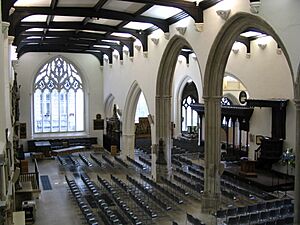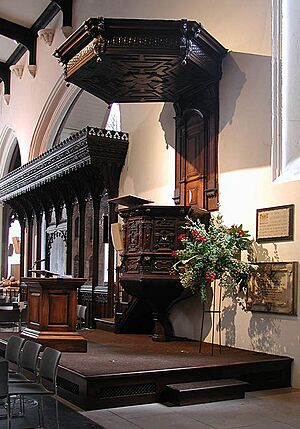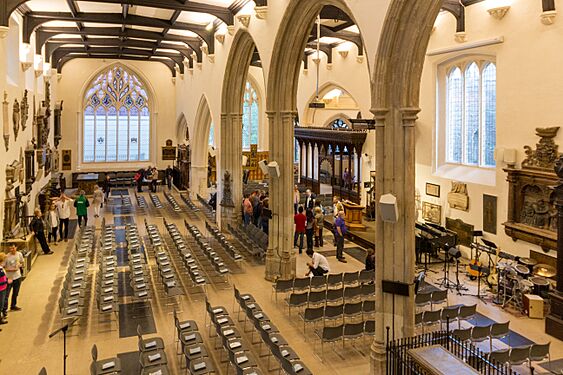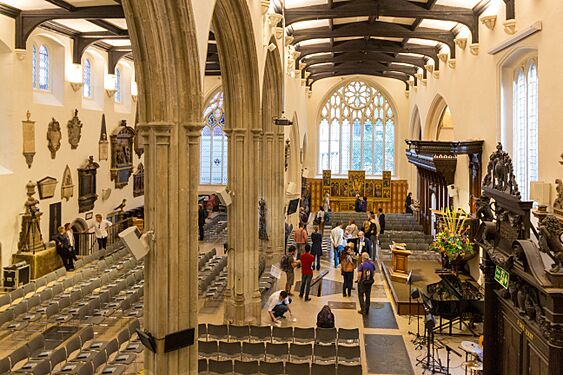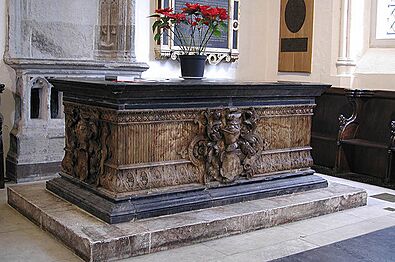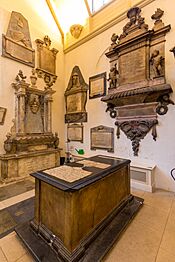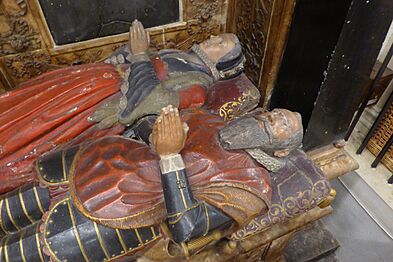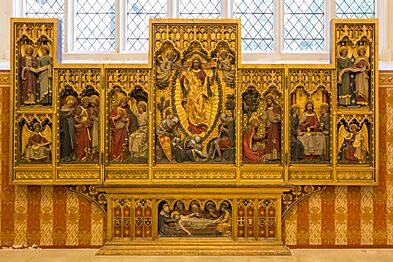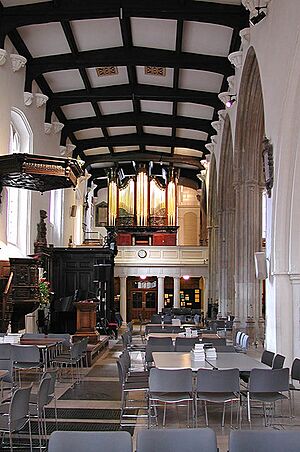St Helen's Church, Bishopsgate facts for kids
Quick facts for kids St Helen's Bishopsgate |
|
|---|---|
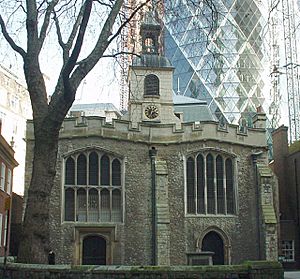
St Helen's Bishopsgate pictured in 2006
|
|
| Location | London, EC3 |
| Country | United Kingdom |
| Denomination | Church of England |
| Previous denomination | Roman Catholicism |
| Churchmanship | Conservative Evangelical Anglican |
| Website | st-helens.org.uk |
| History | |
| Status | Parish Church |
| Architecture | |
| Functional status | Active |
| Heritage designation | Grade I listed building |
| Administration | |
| Parish | St Helen's Bishopsgate with St Andrew Undershaft and St Ethelburga Bishopsgate and St Martin Outwich and St Mary Axe |
| Diocese | London |
St Helen's Bishopsgate is an Anglican church in London. You can find it in Great St Helen's, just off Bishopsgate.
It is the biggest old parish church left in the City of London. Many famous people are buried here. It has more memorials than any other church in Greater London, except for Westminster Abbey. Because of this, some people call it the "Westminster Abbey of the City". William Shakespeare was a regular churchgoer here in the 1590s. St Helen's was one of the few churches in London to survive both the Great Fire of London in 1666 and the Blitz during World War II.
Over the years, smaller church areas joined together. Now, the church's full name is "St Helen's Bishopsgate with St Andrew Undershaft and St Ethelburga Bishopsgate and St Martin Outwich and St Mary Axe". The Worshipful Company of Merchant Taylors helps support the church.
Today, St Helen's has a large group of people who attend services. It follows a conservative evangelical Christian tradition. The church helps people who work in the city, families, students, and young professionals. Every Sunday, there are four services in English and one in Mandarin Chinese. During the week, there are also talks and small group Bible studies.
The nearby churches of St Andrew Undershaft and St Peter upon Cornhill are also looked after by St Helen's.
Contents
History of St Helen's Church
Early Beginnings (Medieval Period)
People think a Roman or Saxon building might have been here first. But the church of St Helen's was first mentioned in the mid-1100s. In 1210, a group of church leaders allowed a man named William to build a Benedictine nunnery. This nunnery was built next to the church that was already there.
The new nunnery church was a bit wider and longer than the parish church. So, the parish church was made longer to match. By 1300, the outer walls of the church were mostly finished. The church was split into two parts by a wall running from east to west. The northern part was for the nuns, and the southern part was for the local people.
In 1480, four big arches were added between the nuns' area and the people's area. A wooden screen was put in place to separate them. Another screen was added in the parish church. This screen separated the chancel (where the altar was) from the nave (where people sat).
There was also a secret underground room, called a crypt, that went north from the church. Next to the church, the nunnery had many buildings. Later, the Worshipful Company of Leathersellers used these buildings. They were taken down in 1799. St Helen's is the only building left from a nunnery in the City of London.
Changes During the Reformation
The nunnery was closed down in 1538 during the Dissolution of the Monasteries. The nunnery's part of the building then became part of the parish church. The screen that separated it was removed. This is why the church has its unusual shape with two main areas.
In the years that followed, the church was changed to fit the ideas of the Reformation. This new way of thinking focused on teaching from the Bible and on everyone taking part in the church service. In 1615, a Jacobean pulpit (a raised stand for preaching) was built in the middle of the south wall. A fancy top, called a tester, was added in 1640. Box pews (seats with high backs) were put in, facing the pulpit.
In the 1600s, many repairs were done. Two fancy wooden door frames were added. By the end of the century, a bell tower was also built. St Helen's was one of only a few churches in the City of London that survived the Great Fire of London in 1666.
A new organ and a special area for it were put in the west end of the church in 1742. Thomas Griffin designed it. In 1874, St Helen's joined with the church of St Martin Outwich. This happened when St Martin Outwich's church was taken down.
Victorian Era Restorations
During the Victorian era, the church was repaired and changed twice. The first time was in 1865. Two stone windows with fancy patterns and stained glass were added.
The second, bigger change happened from 1891 to 1893. John Loughborough Pearson led this work, with help from the church leader, John Alfred Lumb Airey. This work was inspired by the Oxford movement. This movement believed that the most important part of church should be the sacrament of the Eucharist (Communion), not just preaching.
Because of these changes, a new floor was built. It went up in steps from the west to a new high altar in the east. This area had fancy decorations and marble. It was separated again by a new neo-gothic screen. The organ was made bigger and moved. Two more altars were placed in two small chapels. The church reopened in 1893.
For hundreds of years, people had been buried under the church floor. It is thought that over 1,000 bodies were in vaults there. When they started digging for the 1891 changes, some bodies came out. All work had to stop for a year. All the human remains were moved to Ilford Cemetery. A thick concrete slab was then put between the new floor and the old vaults.
20th Century and Today
The church was not damaged during the Blitz in World War II. On January 4, 1950, it was named a Grade I-listed building. This means it is a very important historical building.
When Dick Lucas became the church leader in 1961, St Helen's grew a lot. It went from a few people to a large, busy church. It became known for its strong Bible teaching and preaching. As the City of London grew into a big business area, the church started offering services during the week for city workers. Now, the Sunday services are attended by many different people. These include students, young workers, families, and people from other countries.
In 1992 and 1993, the church was badly damaged. Two bombs from the IRA went off nearby.
Architect Quinlan Terry led a full repair of the church. He liked Georgian architecture. The church was designed to go back to its Reformation style. The floor was made flat again and returned to its original level. This allowed for new heating under the floor, a sound system, and a place for baptisms. A new balcony was built at the west end for more seating and to hold the organ. All the windows were fitted with clear glass. The Victorian screen was turned to open up the old chancel area. A new door was opened. All the altars were removed, and a restored Georgian communion table was put in place.
These changes aimed to make the building focus again on the preaching of the Word. They removed the fancy, ritualistic parts added in Victorian times. This new setup allowed the church to seat 1,000 people, up from 500. It created a large, open space with a clear view of the pulpit and lectern.
The church has stated that it will now get its leadership guidance from other bishops. These bishops are from a group called the Global Fellowship of Confessing Anglicans (GAFCON).
Activities at St Helen's
The church has three English-speaking services every Sunday. They are at 10:30 am, 4:00 pm, and 6:00 pm. A Mandarin-speaking service is held at 2:00 pm on Sundays. Another English service is at 10:00 am at the nearby St Peter upon Cornhill. This service is still part of the St Helen's church family. After the Sunday afternoon and evening services, there is a casual meal. This is a chance to meet new people.
During the week, there are lunchtime talks and meetings. These are for people who work in the City of London. They can hear Christian messages and learn how to live as Christians at work.
Many small groups also meet at the church during the week. Some groups study the Gospel of Mark, the Gospel of John, or the Epistle to the Romans. Others look at different topics and books from the Bible. The church also regularly runs the Christianity Explored course.
Some activities take place at St Peter upon Cornhill and St Andrew Undershaft. These churches are also managed by St Helen's.
The Church Building
The church building you see today was mostly rebuilt between 1993 and 1995. Architect Quinlan Terry did this work. The church had been badly damaged by two IRA bombs in 1992 and 1993.
The repairs made the inside of the church bright, large, and flexible. It can be used in many different ways. It has modern lighting, heating under the floor, and a public address system. Some memorials were lost in the bombings. However, most of them survived and were kept in the building.
Memorials and Tombs
St Helen's has many old and important memorials. Here are some of them:
- Alderman John Robinson (1599): On the north wall, near the west end. It shows him and his wife kneeling with their many children.
- Sir Thomas Gresham (1579): In the north-east corner. He founded the Royal Exchange.
- Sir Julius Caesar Adelmare (1636): In the south transept. He was a judge. His tomb looks like a legal document.
- Sir Andrew Judd (1558): In the south-east corner. He was a Lord Mayor of London and founded Tonbridge School.
- Sir William Pickering (1574): Under the chancel arch, north side. He was an ambassador for Queen Elizabeth I.
- Sir John Crosby (1476): Under the chancel arch, south side. He founded Crosby Hall. His tomb shows him and his wife.
- Sir John Oteswich and his wife: In the south transept. This memorial used to be in the church of St Martin Outwich.
- Sir John Spencer and his wife (1609): Against the south wall. It shows them lying down, with another figure kneeling.
-
Sir Thomas Gresham memorial.
-
Sir Julius Caesar Adelmare memorial.
-
Sir John Spencer memorial
The Church Organ
The organ in St Helen's was first installed in 1742 by Thomas Griffin. It has been repaired and updated many times since then. Builders like George Pike England and Hill, Norman and Beard have worked on it. In 1996, Martin Goetze & Dominic Gwynn restored it. You can find details about the organ on the National Pipe Organ Register.
This organ is very important historically. It has a Grade II* listing from the British Institute of Organ Studies.
Organists of St Helen's
- Thomas Griffin (1744–1771)
- George Griffin (1771–1809)
- William Henry Cutler (1809–1819)
- George Warne (1819–1820)
- Joseph Nightingale (1820–1842/7?)
- William Richard Bexfield (1848–1853)
- Mr Deane (1854)
- William Carter (1856–1859)
- Berthold Tours (1864-1865)
- Miss A. Barton (1867)
- Richard Simpkin (1995–present)
Famous Burials
Many notable people are buried at St Helen's, including:
Church Leaders (Rectors and Curates)
Rectors
- 1541 John Weste
- 1571 Thomas
- 1575 John Olivar
- 1586 ? Lewis
- 1592 Nicholas Felton
- 1600 Lewis Hughes
- 1603 Richard Ball
- 1613 Thomas Downing
- 1618 Thomas Evans
- 1619 William Laurence
- 1621 Joseph Browne
- 1635 Richard Maden
- 1639 Matthias Milward
- 1642 Thomas Edwards
- 1645 Samuel Willis
- 1647 Arthur Barham
- 1663 John Sybbald
- 1666 Thomas Horton
- 1674 Edward Pelling
- 1678 Henry Hesketh
- 1695 Thomas Willis
- 1701 Samson Estwicke
- 1713 William Butler
- 1773 John Naish
- 1795 Robert Watts
- 1799 James Blenkarne
- 1835 Charles Mackenzie
- 1847 John Thomas How Le Mesurier
- 1849 John Edmund Cox
- 1873–1887: John Bathurst Deane
- 1887–1909: John Alfred Lumb Airey
- 1909 Silvanus Taylor Hingston Saunders
- 1951–1953: Ronald Goodchild
- 1953–1961: John Miller
- 1961–1998: Dick Lucas
- 1998–present: William Taylor
Curates
- 1954–1958: Gordon Jones
- 1958–1960: Peter Coleman
- 1961–1967: David Macinnes
- 1970–1973: Ian Barclay
- 1973–1978: Robert Howarth
- 1976–1981: Jonathan Fletcher
- 1977–1978: Thomas Oates
- 1978–1982: James Spence
- 1982–1984: Simon Manchester
- 1985–1995: Hugh Palmer
- 1990–1995: Justin Mote
- 1994–1996: Carrie Sandom
- 1994–1998: Richard Coombs
- 1995–1998: William Taylor, now Rector
- 1995–1998: Jonathan Juckes
- 1998–2007: Nigel Beynon
- 2000–2005: Simon Dowdy
- 2002–2005: James de Costobadie
- 2003–present: Charlie Skrine
- 2003–2007: Ben Cooper
- 2004–2011: Mark O'Donoghue
- 2004–2009: Lee Gatiss
- 2005–present: Matt Fuller
- 2007–2017: Andrew Sach
- 2007–2012: Chris Fishlock
- 2007–2013: Paul Clarke
- 2007–2010: Andrew Towner
- 2009–present: Aneirin Glyn
- 2009–2014: Thomas Nash
- 2010–2017: Jamie Child
- 2016–present: Mickey Mantle
New Churches Started by St Helen's
St Helen's has helped start many new churches. Some are part of the Church of England, and some are independent.
| Name | Location | Type | Affiliation | Founded | Minister | Notes |
|---|---|---|---|---|---|---|
| Christ Church, Mayfair | Mayfair | Church | Diocese of London | 2001 | Matt Fuller | |
| St Peter's Barge | Canary Wharf | Church | Diocese of London | 2003 | Marcus Nodder | Britain's only church on a boat |
| Grace Church Dulwich | Dulwich | Church | Diocese of Southwark | 2005 | Simon Dowdy | Meets in a local primary school |
| Grace Church Wanstead | Wanstead | Church | Independent | 2006 | David Gibbs | Meets in Wanstead House |
| Grace Church Hackney | Hackney | Church | Diocese of London | 2004 | Andrew Jones | Meets in St Anne's, Hoxton |
| Trinity Church Islington | Islington | Church | Diocese of London | 2007 | Jeremy Hobson | Meets in St Mark's, Myddelton Square |
| Euston Church | Bloomsbury | Church | Diocese of London | 2010 | Kev Murdoch | Since 2015 has met in Church of Christ the King, Bloomsbury |
| Grace Church Brockley | Brockley | Church | FIEC | 2011 | Raymond Brown | Meets in Crofton Park Baptist Church |
| Redeemer, Croydon | Croydon | Church | FIEC | 2013 | Will Dobbie | Meets in a local primary school |
| Grace Church Sydenham | Sydenham | Church | Anglican Mission in England | 2015 | Tim Iles | Meets in a youth centre |
| Grace Church Greenwich | Greenwich | Church | Diocese of Southwark | 2015 | Andrew Latimer | Meets in Old Royal Naval College |
| Crossway, Stratford | Stratford | Church | Independent | 2016 | Jamie Child | Meets in university buildings |
| St Nicholas Cole Abbey | City of London | Church | Diocese of London | 2016 | Chris Fishlock | Sunday services restarted for first time since 1941 |
| Covent Garden Talks | Covent Garden | Lunchtime talks | Meets at the Swiss Church, Endell Street | |||
| Euston Area Talks | Bloomsbury | Lunchtime talks | Meets in Church of Christ the King, Bloomsbury | |||
| Fleet Street Talks | Fleet Street | Lunchtime talks | Meets in a building on Fleet Street | |||
| London Bridge Network | London Bridge | Lunchtime talks | ||||
| Moorgate Talks | Moorgate | Lunchtime talks | ||||
| St Botolph's, Aldersgate | City of London | Lunchtime talks | Diocese of London | Simon Dowdy | Church used for lunchtime talks but not for regular services | |
| Westminster@One | Westminster | Lunchtime talks | 2000 | Meets in Methodist Central Hall |
See also
- List of buildings that survived the Great Fire of London
- List of English abbeys, priories and friaries serving as parish churches


